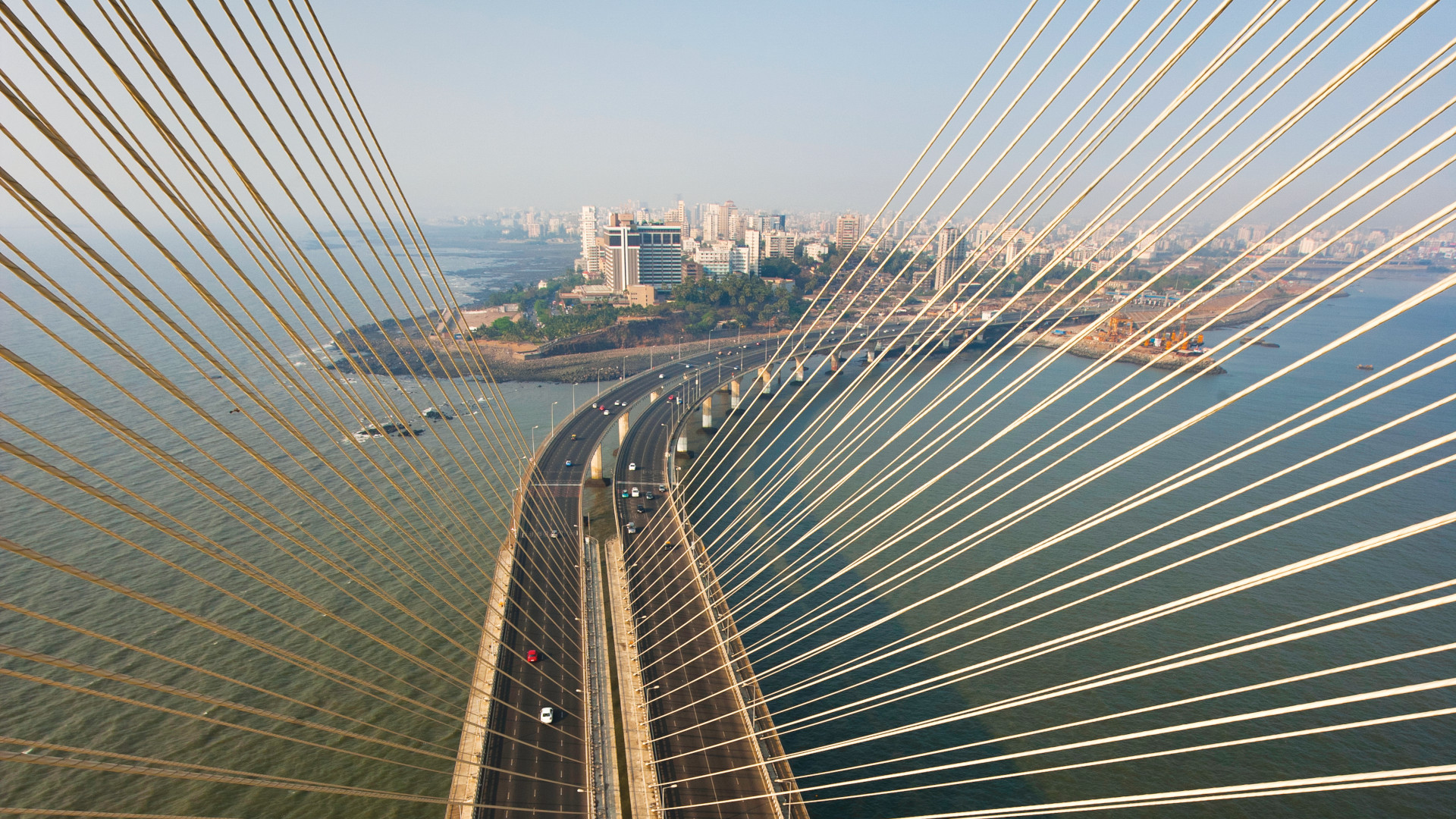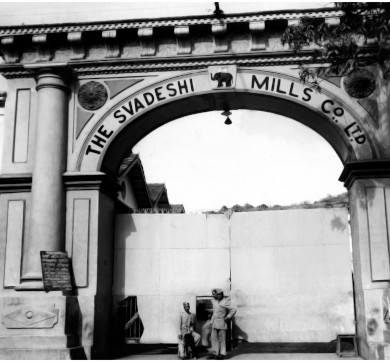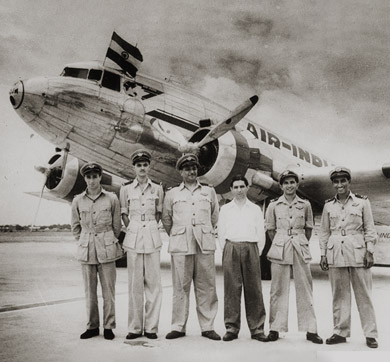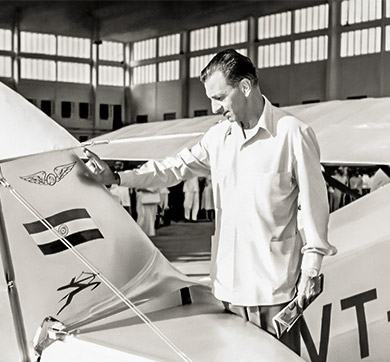March 2023 | 3086 words | 12-minute read
As India woke up to freedom on August 15, 1947, it also found itself on a political and economic precipice. JRD Tata, who led the group through the transition from British India to independent India, marshalled Tata resources to address the challenge. In a letter to group employees dated that very day, he highlighted the “immense task of building the new India”.
He wrote, “How do Tatas fit into this picture? ... The fruits of their pioneering and enterprise are now held in trust for the benefit of the people… Let us together harness its resources to the task of national reconstruction and development.”
Unshackled from colonialism, JRD gave wings to India, literally and figuratively. In 1948, within a year of independence, he launched Air-India International, India’s first international airline. He followed it up with iconic and successful companies like Voltas (1954), Tata Consulting Engineers (TCE, 1962), Tata Tea (1964, now Tata Consumer Products), Tata Consultancy Services (TCS, 1968), Tata Projects (1979), Titan Company (1984) and Tata Elxsi (1989).
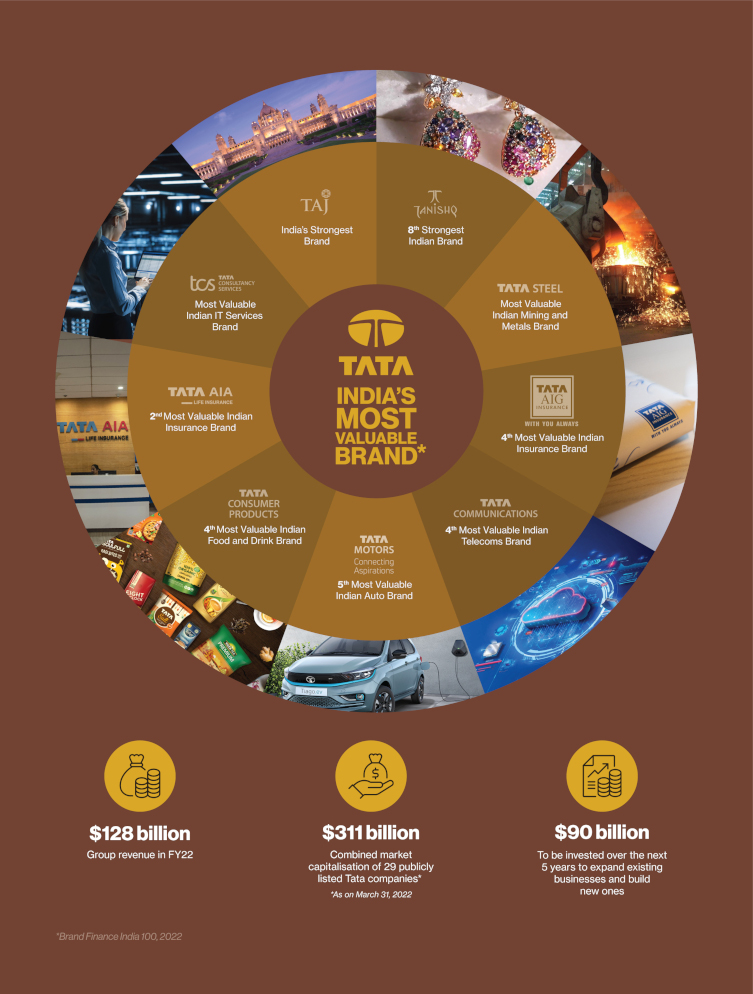
Separately, each addition emerged out of a specific, sometimes unseen, need in the nation. Together, they became an unparalleled force for nation building.
Take, for instance, Tata Salt. When the government permitted private sector participation in salt iodisation for the National Goitre Control Programme in the early 1980s, Tata Chemicals stepped up immediately. By 1983, it had launched Tata Salt, India’s first branded iodised salt, to battle iodine deficiency. And the impact was huge. According to the Food Safety and Standards Authority of India, adequate salt iodisation in India saved 4 billion IQ points in 25 years!
Or consider TCS. Though the India of the 1950s and 1960s was struggling to emerge from colonialism amidst wars, poverty and a controlled economy, JRD had the foresight to invest in computers for business and society. The birth of TCS not only gave India its first software services company but also launched the Indian IT services industry. An industry that has employed millions of Indians — TCS alone reported a workforce of 606,331 as on June 30, 2022 — who have become the backbone of an increasingly digital world and put the nation on a path towards tech-enabled progress.
The company is today instrumental in running the economic backbone of the country, covering stock exchanges, regulators, depositaries, manufacturing, retail and utilities. Among the financial institutions and systems powered by TCS are the Bombay Stock Exchange, the National Stock Exchange, the Reserve Bank of India’s online payment systems of NEFT and RTGS, the Securities and Exchange Board of India’s surveillance system and several large Indian banks. It has also partnered with the government to bring legacy departments into the digital age. TCS transformed India’s passport issuance system and is modernising India Post, connecting its network of 150,000+ post offices to make it the largest distributed ePostal network in the world.
In the true spirit of its oft used descriptor, ‘the salt to software conglomerate’, the 75 years since independence have seen the Tata group underpin the creation of modern India.
Make in India, build for India
In the 1950s, when India embraced the era of planned large-scale industrial and infrastructure development with successive Five-Year Plans, Tata companies contributed to the building of everything from dams, bridges and transportation to entire cities. Steel from Tata went into the building of dams like Bhakra-Nangal, while Voltas — known to most as the manufacturer of the first Indian air conditioner — helped construct dams like the Tungabhadra, Rihad and Vaitarna. Tata Steel went into two-thirds of the country’s flyovers and bridges, including landmark ones like Kolkata’s Howrah bridge; Mumbai’s Bandra-Worli Sea Link and Assam’s Bogibeel Bridge, India’s largest rail-cum-road bridge. It even went into building cities like Chandigarh.
Speaking of cities, the Tatas — known for building places like Jamshedpur, India’s first industrial city; Mithapur and Tatapuram before independence — are now readying cities for the future. TCE is design engineering and project managing the smart city projects of Guwahati in Assam; Raipur in Chhattisgarh; Bhopal and Satna in Madhya Pradesh; Ahmedabad, Surat, Vadodara, Gandhinagar, Silvassa and Dahod in Gujarat; Shivamogga in Karnataka; Agartala in Tripura; Hubballi in Karnataka; Dehradun in Uttarakhand; and Rourkela in Odisha. It is also engineering the brownfield upgrade of around 50 towns.
In this endeavour for industrial development, however, the group never forgot the agricultural roots of the Indian economy. While Tata Steel retained focus on manufacturing agricultural tools after independence — fun fact: today, their steel is in every third agricultural hand tool and borewell — Voltas took equipment right to the farmer. “One of its first major ventures was creating a remarkable Farmer’s Training Unit in 1955 to increase mechanisation and productivity in the agricultural sector,” the book Horizons documents. “Instead of waiting for the farmer to come to a showroom in the city, Voltas took large complements of agricultural machinery and equipment to the farm itself.” Rallis India, meanwhile, manufactured seeds, crop protection and crop nutrition.
Did you know that the Tatas also played an important role in Operation Flood in the 1970s? Voltas was not only a distributor for Amul, but also developed milk vending machines for the National Dairy Development Board to support the world’s biggest dairy development programme.
Putting people first
Along with industry, the Tata group has also played a pioneering role in employee welfare in the country. When Tata group Founder Jamsetji Tata started the Central India Spinning, Weaving and Manufacturing Company in the 1870s, he introduced labour welfare initiatives never before attempted in India. He offered his people shorter working hours, well-ventilated workplaces, a crèche, provident fund and gratuity long before they became statutory in the west. In 1886, he instituted a pension fund, and in 1895, began to pay accident compensation. He even installed a water filtration plant, arranged for sanitary hutments, opened a grain depot and a dispensary.
His heirs built on the legacy. Tata Steel, under Sir Dorabji Tata, introduced initiatives like eight-hour workday and leave with pay, which were only later adopted by the International Labour Organization and enacted by the law in India. The company, under JRD Tata, also introduced the first human resources department of India Inc.
The group’s people-first approach continues to translate to industry-first initiatives. TCS, Tata Steel, Tata Chemicals and Tata Consumer Products have extended health insurance to partners of LGBTQ+ employees. TCS and Tata Steel also support employees seeking gender affirmation surgeries with medical leave and financial aid. Tata Steel is the first company in India to deploy women in all shifts in mines and the first Indian company to open core mining operations to the transgender community, while Tata Motors has deployed all women units in a traditionally male-dominated sector like automotive manufacturing.
As the largest private sector employer in the country, with 935,000+ employees, these steps taken by the Tata group continue to create significant impact on employee welfare in the country.
India on the world map
And when the time came for India to take her place in the world economy, the Tata group led the way once again.
Ratan N Tata, Chairman Emeritus, Tata Sons, took over as the chairman of Tata Sons in 1991 just as India embraced liberalisation. He saw in it the opportunity to further the global ambitions of Indian industry. Under him, the group began to make global acquisitions — often bringing home iconic brands — on a scale that was unprecedented for an Indian company. Tata Tea acquired Tetley, Tata Steel acquired Corus, Tata Motors acquired Jaguar Land Rover, adding heft to not just the group but Indian industry at large.
Building intellectual capital
Jamsetji Tata knew the importance of science and technology education for a nation that wished to be truly self-reliant. Apart from supporting institutes of world-class education, just like the Founder did with the Indian Institute of Science, the Tata group has also made massive investments in research and innovation to further industry in India.
Tata Steel set up its Research and Control Laboratory in 1937; not only was it India’s first industrial R&D division but also among the first in Asia. Tata Motors set up its Engineering and Research Centre in 1966, which enabled it to pioneer products like India’s first indigenously developed light commercial vehicle, India’s first SUV, India’s first fully indigenous passenger car, and India’s first indigenously developed mini truck. In 1981, TCS established the Tata Research Development and Design Centre, India’s first dedicated software research and development centre. The company has since established a network of innovation labs around the globe.
The Tata Chemicals Innovation Centre was set up in 2004 to focus on performance materials, nutritional sciences, green chemistry and sustainable materials. In 2022, Titan Company set up Titan Smart Labs, a dedicated engineering centre, to shape innovative and diversified products for the company.
A nation on the move
Through it all, the Tatas have kept India moving by rail, in air and on road.
After manufacturing locomotives in the 1940s and ’50s, Tata companies are now putting the country’s metro rail networks on track. Tata Projects has built the Lucknow, Delhi and Ahmedabad metro rail projects and is executing the same in Mumbai, Pune and Chennai. Tata Elxsi has designed the end-to-end passenger experience for the Kochi Metro. Voltas executed MEP (mechanical, electrical and plumbing) for the Delhi metro while its HVAC (heating, ventilation and air conditioning) is cooling sections of the Mumbai and Chennai metros. And Tata Steel has gone into almost all of them. In addition, Tata Projects has built 1,700 track km (Tkm) of railway network and executed 4,550Tkm of railway overhead electrification.
After giving India her first airline, the group is now helping India build airports. Tata Steel has strengthened 40+ modern airports, while Voltas MEP powers the Kolkata, Chennai and Hyderabad airports. TCE is engineering the modernisation and expansion of Delhi airport and new Bengaluru international airport, while Tata Projects has built the Prayagraj Airport terminal and is executing the Noida International Airport. Technology powered by TCS supports airports in multiple cities, including Bengaluru, while Tata Elxsi has designed the passenger and staff experience at Mumbai’s international airport and been chosen to improve passenger experience at all airports managed by the Airports Authority of India.
After engineering the country’s first made-in-India trucks in 1954 and the first fully indigenous car in 1998, Tata Motors is now leading the country’s transition to electric vehicles and the future of mobility.
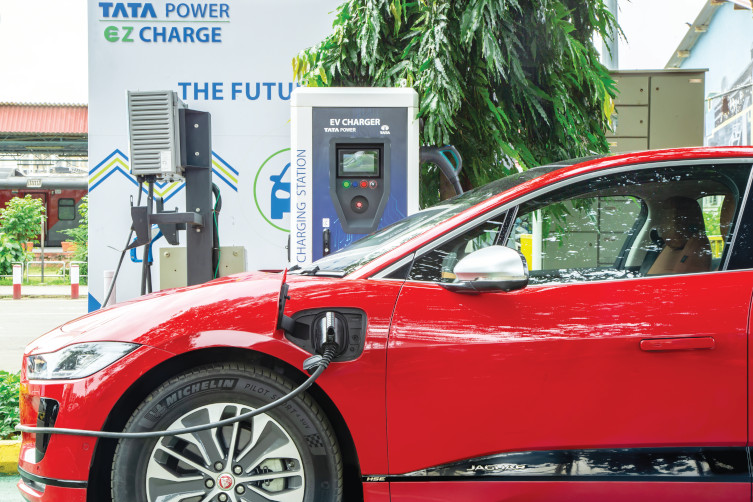
Electric aspirations
The group is also putting the electric in the EV. A part of the Tata UniEVerse, created to build the EV ecosystem for India, Tata Power has installed EV charging points across 25+ states and five union territories.
The Tatas have played a key role in bringing electricity to India since 1915 and continue to do so across generation, transmission and distribution. Tata Power is India’s largest integrated power company with a domestic generation capacity of 14,076MW, serving 19 states and union territories. In addition, TCE, which was the first to engineer the 120MW, 200MW, and 500MW power plants in India, contributes to about 198GW+ of the country’s aggregate installed power generation capacity. Tata transmission lines run across 19,000+ckm (circuit kilometre) of the country — 15,500ckm+ built by Tata Projects and 3,500ckm+ belonging to Tata Power. Built over mountains, through forests, across rivers and deserts, they form the backbone of India’s high-capacity power transmission. Tata Power’s distribution arm, meanwhile, serves 12.3 million Indians and counting.
The group has simultaneously taken the lead in securing the future of energy. Thirty-seven percent (5,216MW) of Tata Power’s current generation portfolio is clean and green, with Tata Power Solar retaining its position as the No 1 solar EPC player for eight years in a row. The company is also gearing up to address the enduring challenge of energy poverty in the darkest corners of India with microgrids and new energy storage systems.
Preserving heritage
Not many know that it was Sir Ratan Tata who funded the country’s first archaeological excavation at Pataliputra between 1913 and 1917. The endeavour led to the discovery of King Ashoka’s 100-column throne room and many more artefacts of national importance. The Tatas will also always be remembered in the museum movement in early 20th-century India for the bequests from Sir Ratan and Sir Dorabji Tata, which formed the core of the Chhatrapati Shivaji Maharaj Vastu Sangrahalaya in Mumbai. The group has continued to recognise the importance of conserving the nation’s rich heritage and culture and tackled the challenge on various levels:
- It has supported the restoration of monuments of national importance like the Ajanta and Ellora Cave, Humayun’s Tomb, etc and helps maintain others like the Gateway of India.
- As the country’s largest palace operator, it has emerged as a custodian of royal architecture. Indian Hotels Company Ltd has undertaken restoration work at the Taj Lake Palace (1746) in Udaipur, Umaid Bhawan Palace (built between 1928 and 1943) in Jodhpur and Taj Falaknuma Palace (1894) in Hyderabad. Palaces operated by Taj also include Jai Mahal Palace (1745) and Rambagh Palace (1835) in Jaipur, Taj Usha Kiran Palace (1880) in Gwalior, Taj Nadesar Palace (1835) in Varanasi, and Taj Fateh Prakash Palace (19th century) in Udaipur.
- The group promotes handloom heritage with interventions like Tata Trusts’ Antaran, IHCL’s Livelihood Support Programme, Taneira’s Weavershala and Tata Chemicals’ Okhai.
- Tata Steel helps preserve tribal heritage with initiatives like the Tribal Cultural Society and Samvaad, a tribal conclave.
In defence of the nation
Another challenge that has endured for India over the post-independence decades is its unique geopolitical vulnerabilities. Technologies developed by the Tatas have addressed this for decades.
Tata Advanced Systems Ltd (TASL) has engineered products across the military vehicles spectrum from logistics to frontline combat, including India’s first amphibious infantry combat vehicle, the WhAP 8x8; supported airborne platforms and systems; and delivered solutions across the technology spectrum for vital military programmes. They have developed weapons systems and control systems for artillery. They have developed mission critical software for electronic warfare for all branches of the armed forces, executed the Indian Navy’s surface surveillance radar project and delivered machinery control systems for the Indian Navy and the integrated materials management online system for the Indian Air Force. Did you know that the combat management system of INS Vikrant, India’s first indigenous aircraft carrier, which brings together all the warfighting and self-defence capabilities of the ship, has been developed by TASL?
And the company is set on a historic course. It will make the C-295 transport aircraft, marking the beginning of full-scale aircraft manufacturing in India by the private sector.
Keeping community at the core
"The wealth gathered by Jamsetji Tata and his sons in half a century of industrial pioneering formed but a minute fraction of the amount by which they enriched the nation. The whole of that wealth is held in trust for the people and used exclusively for their benefit. The cycle is thus complete; what came from the people has gone back to the people many times over,” JRD Tata once said.
The Tata Trusts, with two-thirds of the shareholding of Tata Sons, uses the wealth accrued to support social causes. Over the decades, they have addressed developmental challenges across the length and breadth of the country in areas like healthcare, education, nutrition, water, sanitation and hygiene, environment and energy, livelihood, skill development, migration and urban habitat, social justice and inclusion, disaster relief and rehabilitation, arts and culture, sports, institutions and more. They have also helped build some of India’s most iconic institutions covering this spectrum of interventions. These include the Tata Institute of Social Sciences, the Tata Memorial Hospital, the Tata Institute of Fundamental Research and the National Centre for Performing Arts.
And now, under the leadership and vision of Ratan N Tata, Chairman Emeritus, Tata Sons, and Chairman, Tata Trusts, they have shifted focus from grant giving to implementing nearly 80 percent of the programmes directly. This increased ownership has enabled the Trusts to affect greater change. In FY21, the Trusts deployed $136 million across its social initiatives to benefit millions across 100+ districts of India.
“We shall focus a lot more on social impact,” Tata Sons Chairman N Chandrasekaran told Brand Finance earlier this year. “The Tata Group, led by Tata Trusts, Tata Sons and all the operating companies, spends a significant amount of effort, resources (both human resources and financial resources) in addressing social issues, to create impact globally, and in India. We shall scale it up, as we want to be able to make much larger impact in solving some of the biggest problems in the social environment.”
On to 'India's decade'
The Tata group, the country’s biggest business — measured by market value ($269bn) and operating profits ($16bn last year) — and its most valuable brand, according to Brand Finance 2022, is now focused on building businesses of the future for India. It is on the frontlines of leading India into Industry 4.0. Tata Steel Kalinganagar was the first Indian manufacturing plant to be recognised as a World Economic Forum Lighthouse of the Fourth Industrial Revolution. The group is expected to make a $90bn investment in the energy transition to renewables; building self-reliance for industry; creating new businesses like electronics manufacturing, batteries; next generation telecom technologies like 5G and beyond — all aimed at leveraging global opportunities for the country.
As India celebrates 75 years of independence, the Tata group stands poised to lead the country into Industry 5.0 and what Tata Sons Chairman N Chandrasekaran believes will be “India’s decade”, staying true to the belief that “what is good for India is good for the Tatas”.
—Monali Sarkar

